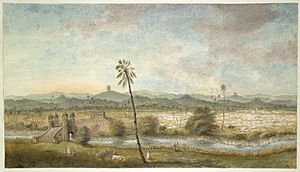Thomas Adams (British Army officer) facts for kids
Quick facts for kids
Thomas Adams
|
|
|---|---|
| Born | c. 1730 |
| Died | January 1764 Calcutta, Bengal |
| Allegiance | Great Britain |
| Service/ |
British Army |
| Years of service | 1747–1764 |
| Rank | Major |
| Unit | 37th Regiment of Foot 84th Regiment of Foot |
| Battles/wars | War of the Austrian Succession Third Carnatic War |
Thomas Adams (born around 1730 – died January 1764) was a brave British Army major. He was later given the higher rank of Brigadier-general after his death. This was because of his important role in defending the British in Bengal in 1763.
Contents
Thomas Adams: A British Military Hero
Early Military Career
Thomas Adams started his military journey in 1747. He volunteered to join the army led by the Duke of Cumberland in the Netherlands. On June 25 of that same year, he became an ensign (a junior officer) in the 37th Foot regiment.
He worked his way up the ranks. Nine years later, he became a captain. Later, he moved to the 84th Foot regiment.
Leading Forces in India
By 1762, Adams was serving as a major in India. This was five years after the important Battle of Plassey. He was then chosen to lead all the British forces in Bengal. These forces included both the King's army and soldiers from the East India Company.
This was a very challenging time for the British in India. Even after their victory at Plassey, their power was not fully secure. Robert Clive, a famous British leader, was back in England. A clever minister named Mir Qasim had become the new ruler, or Nawab, of Bengal.
Facing a Tough Challenge
There were many problems between the British and the Nawab. British officials were causing trouble by being unfair in trade. This made the Nawab lose money and made the British look bad.
Arguments about taxes and an attack on the city of Patna led to war. Major Adams faced a huge challenge. The Nawab's army had 40,000 soldiers. This included 25,000 trained infantry and strong artillery.
Major Adams had a much smaller force. He had only about 2,300 to 3,000 troops. Only 850 of these were Europeans. His cannons were also not as good as the enemy's.
Key Battles and Victories
The war began on July 2, 1763, and lasted four months. During this time, Adams fought four major battles. He captured two large forts and nearly 500 cannons. He completely defeated the strongest Bengali army the British had ever faced.
One key battle was the Battle of Gheriah in August 1763. It was a tough fight, lasting four hours. At one point, the Nawab's troops broke through the British line. They even captured two cannons. But the bravery of the European soldiers and the steady sepoys (Indian soldiers) saved the day. Adams's leadership was key. The enemy had to retreat, losing all their cannons and supplies.
Another important fight was the Battle of Udhanala in September 1763. Adams chased the Nawab's troops to the city of Monghyr. He then attacked Patna, where he won another victory. Sadly, before his defeat, Nawab Qasim killed about 60 British prisoners. Adams continued to pursue Qasim's remaining soldiers for a few more days. He then returned to Calcutta. In just a few months, he had conquered all of Bengal.
His Legacy
After this successful campaign, Major Adams became very ill. He had to give up his command. He sadly passed away in Calcutta in January 1764.
When news of his amazing victories reached England, Adams was promoted. He was given the rank of brigadier-general. However, he had already died several months before his promotion was officially announced.


